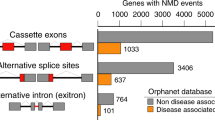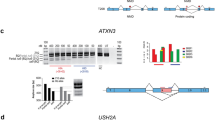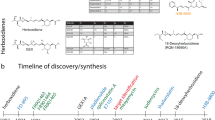Abstract
Differential exon use is a hallmark of alternative splicing, a prevalent mechanism for generating protein isoform diversity. Many disease-associated mutations also affect pre-mRNA splicing, usually causing inappropriate exon skipping. SR proteins are essential splicing factors that recognize exonic splicing enhancers and drive exon inclusion. To emulate this function of SR proteins, we designed small chimeric effectors comprising a minimal synthetic RS domain covalently linked to an antisense moiety that targets an exon by Watson-Crick base pairing. Here we show that such synthetic effectors can mimic the functions of SR proteins and specifically restore wild type splicing when directed to defective BRCA1 or SMN2 pre-mRNA transcripts. This general approach can be used as a tool to investigate splicing mechanisms and modulate alternative splicing of specific genes, and as a therapeutic strategy to correct splicing defects responsible for numerous diseases.
This is a preview of subscription content, access via your institution
Access options
Subscribe to this journal
Receive 12 print issues and online access
$189.00 per year
only $15.75 per issue
Buy this article
- Purchase on Springer Link
- Instant access to full article PDF
Prices may be subject to local taxes which are calculated during checkout




Similar content being viewed by others
References
Burge, C.B., Tuschl, T. & Sharp, P.A. Splicing of precursors to messenger RNAs by the spliceosome. in The RNA World II (eds. Gesteland, R.F., Cech, T.R. & Atkins, J.F.) 525–560 (Cold Spring Harbor Laboratory Press, Cold Spring Harbor; 1999).
Cartegni, L., Chew, S.L. & Krainer, A.R. Listening to silence and understanding nonsense: exonic mutations that affect splicing. Nat. Rev. Genet. 3, 285–298 (2002).
Maniatis, T. & Tasic, B. Alternative pre-mRNA splicing and proteome expansion in metazoans. Nature 418, 236–243 (2002).
Graveley, B.R. Sorting out the complexity of SR protein functions. RNA 6, 1197–1211 (2000).
Zhu, J., Mayeda, A. & Krainer, A.R. Exon identity established through differential antagonism between exonic splicing silencer-bound hnRNP A1 and enhancer-bound SR proteins. Mol. Cell 8, 1351–1361 (2001).
Krawczak, M., Reiss, J. & Cooper, D.N. The mutational spectrum of single base-pair substitutions in mRNA splice junctions of human genes: causes and consequences. Hum. Genet. 90, 41–54 (1992).
Ars, E. et al. Mutations affecting mRNA splicing are the most common molecular defects in patients with neurofibromatosis type 1. Hum. Mol. Genet. 9, 237–247 (2000).
Teraoka, S.N. et al. Splicing defects in the ataxia-telangiectasia gene, ATM: underlying mutations and consequences. Am. J. Hum. Genet. 64, 1617–1631 (1999).
Sierakowska, H., Gorman, L., Kang, S.H. & Kole, R. Antisense oligonucleotides and RNAs as modulators of pre-mRNA splicing. Methods Enzymol. 313, 506–521 (2000).
Lacerra, G. et al. Restoration of hemoglobin A synthesis in erythroid cells from peripheral blood of thalassemic patients. Proc. Natl. Acad. Sci. USA 97, 9591–9596 (2000).
Friedman, K.J. et al. Correction of aberrant splicing of the cystic fibrosis transmembrane conductance regulator (CFTR) gene by antisense oligonucleotides. J. Biol. Chem. 274, 36193–36199 (1999).
Taylor, J.K., Zhang, Q.Q., Wyatt, J.R. & Dean, N.M. Induction of endogenous Bcl-xS through the control of Bcl-x pre-mRNA splicing by antisense oligonucleotides. Nat. Biotechnol. 17, 1097–1100 (1999).
Wilton, S.D. et al. Specific removal of the nonsense mutation from the mdx dystrophin mRNA using antisense oligonucleotides. Neuromuscul. Disord. 9, 330–338 (1999).
Epstein, P.M. Antisense inhibition of phosphodiesterase expression. Methods 14, 21–33 (1998).
Celotto, A.M. & Graveley, B.R. Exon-specific RNAi: a tool for dissecting the functional relevance of alternative splicing. RNA 8, 718–724 (2002).
Nakai, K. & Sakamoto, H. Construction of a novel database containing aberrant splicing mutations of mammalian genes. Gene 141, 171–177 (1994).
Graveley, B.R. & Maniatis, T. Arginine/serine-rich domains of SR proteins can function as activators of pre-mRNA splicing. Mol. Cell. 1, 765–771 (1998).
Zhu, J. & Krainer, A.R. Pre-mRNA splicing in the absence of an SR protein RS domain. Genes Dev. 14, 3166–3178 (2000).
Cazalla, D. et al. Nuclear export and retention signals in the RS domain of SR proteins. Mol. Cell. Biol. 22, 6871–6882 (2002).
Nielsen, P.E. Antisense properties of peptide nucleic acid. Methods Enzymol. 313, 156–164 (2000).
Pooga, M. et al. Cell penetrating PNA constructs regulate galanin receptor levels and modify pain transmission in vivo. Nat. Biotechnol. 16, 857–861 (1998).
Sazani, P. et al. Nuclear antisense effects of neutral, anionic and cationic oligonucleotide analogs. Nucleic Acids Res. 29, 3965–3974 (2001).
Tyler, B.M. et al. Peptide nucleic acids targeted to the neurotensin receptor and administered i.p. cross the blood-brain barrier and specifically reduce gene expression. Proc. Natl. Acad. Sci. USA 96, 7053–7058 (1999).
Liu, H.X., Cartegni, L., Zhang, M.Q. & Krainer, A.R. A mechanism for exon skipping caused by nonsense or missense mutations in BRCA1 and other genes. Nat. Genet. 27, 55–58 (2001).
Mazoyer, S. et al. A BRCA1 nonsense mutation causes exon skipping. Am. J. Hum. Genet. 62, 713–715 (1998).
Cartegni, L. & Krainer, A.R. Disruption of an SF2/ASF-dependent exonic splicing enhancer in SMN2 causes spinal muscular atrophy in the absence of SMN1. Nat. Genet. 30, 377–384 (2002).
Graveley, B.R., Hertel, K.J. & Maniatis, T. A systematic analysis of the factors that determine the strength of pre-mRNA splicing enhancers. EMBO J. 17, 6747–6756 (1998).
Jablonka, S., Rossoll, W., Schrank, B. & Sendtner, M. The role of SMN in spinal muscular atrophy. J. Neurol. 247 (Suppl. 1), I37–I42 (2000).
Monani, U.R. et al. A single nucleotide difference that alters splicing patterns distinguishes the SMA gene SMN1 from the copy gene SMN2. Hum. Mol. Genet. 8, 1177–1183 (1999).
Lorson, C.L., Hahnen, E., Androphy, E.J. & Wirth, B. A single nucleotide in the SMN gene regulates splicing and is responsible for spinal muscular atrophy. Proc. Natl. Acad. Sci. USA 96, 6307–6311 (1999).
Hofmann, Y., Lorson, C.L., Stamm, S., Androphy, E.J. & Wirth, B. Htra2-β1 stimulates an exonic splicing enhancer and can restore full-length SMN expression to survival motor neuron 2 (SMN2). Proc. Natl. Acad. Sci. USA 97, 9618–9623 (2000).
Young, P.J. et al. SRp30c-dependent stimulation of survival motor neuron (SMN) exon 7 inclusion is facilitated by a direct interaction with hTra2β1. Hum. Mol. Genet. 11, 577–587 (2002).
Andreassi, C. et al. Aclarubicin treatment restores SMN levels to cells derived from type I spinal muscular atrophy patients. Hum. Mol. Genet. 10, 2841–2849 (2001).
Chang, J.G. et al. Treatment of spinal muscular atrophy by sodium butyrate. Proc. Natl. Acad. Sci. USA 98, 9808–9813 (2001).
Zhang, M.L., Lorson, C.L., Androphy, E.J. & Zhou, J. An in vivo reporter system for measuring increased inclusion of exon 7 in SMN2 mRNA: potential therapy of SMA. Gene Ther. 8, 1532–1538 (2001).
Miyajima, H., Miyaso, H., Okumura, M., Kurisu, J. & Imaizumi, K. Identification of a cis-acting element for the regulation of SMN exon 7 splicing. J. Biol. Chem. 277, 23271–23277 (2002).
Lim, S.R. & Hertel, K.J. Modulation of survival motor neuron pre-mRNA splicing by inhibition of alternative 3′ splice site pairing. J. Biol. Chem. 276, 45476–45483 (2001).
Wagner, E.J. & Garcia-Blanco, M.A. Polypyrimidine tract binding protein antagonizes exon definition. Mol. Cell. Biol. 21, 3281–3288 (2001).
Acknowledgements
Supported by the NIH. We thank L. Manche for technical assistance, and R. Del Vecchio, M. Hastings and B. Stillman for helpful comments.
Author information
Authors and Affiliations
Corresponding author
Ethics declarations
Competing interests
A patent application has been filed by the authors and Cold Spring Harbor Laboratory.
Rights and permissions
About this article
Cite this article
Cartegni, L., Krainer, A. Correction of disease-associated exon skipping by synthetic exon-specific activators. Nat Struct Mol Biol 10, 120–125 (2003). https://doi.org/10.1038/nsb887
Received:
Accepted:
Published:
Issue Date:
DOI: https://doi.org/10.1038/nsb887
This article is cited by
-
Heat increases full-length SMN splicing: promise for splice-augmenting therapies for SMA
Human Genetics (2022)
-
RNA isoform screens uncover the essentiality and tumor-suppressor activity of ultraconserved poison exons
Nature Genetics (2020)
-
New Insights in RBM20 Cardiomyopathy
Current Heart Failure Reports (2020)
-
Full-length transcript amplification and sequencing as universal method to test mRNA integrity and biallelic expression in mismatch repair genes
European Journal of Human Genetics (2019)
-
Splicing isoform-specific functional genomic in cancer cells
Applied Cancer Research (2018)



